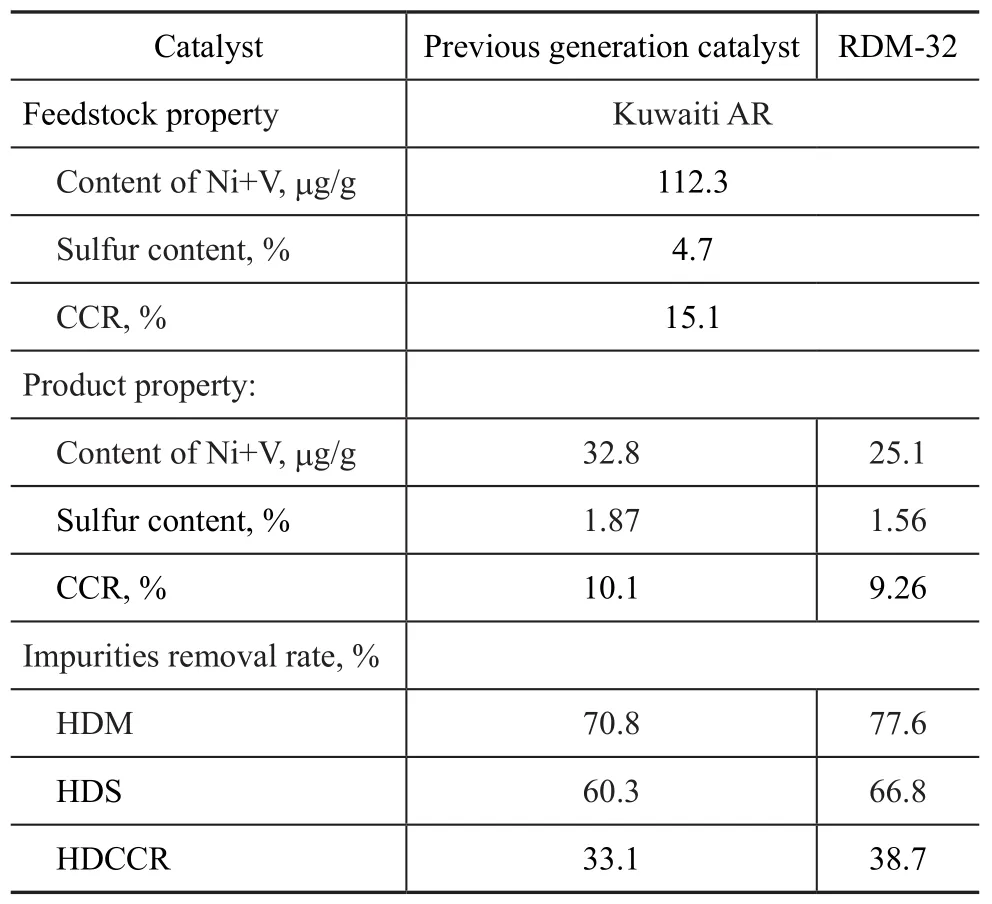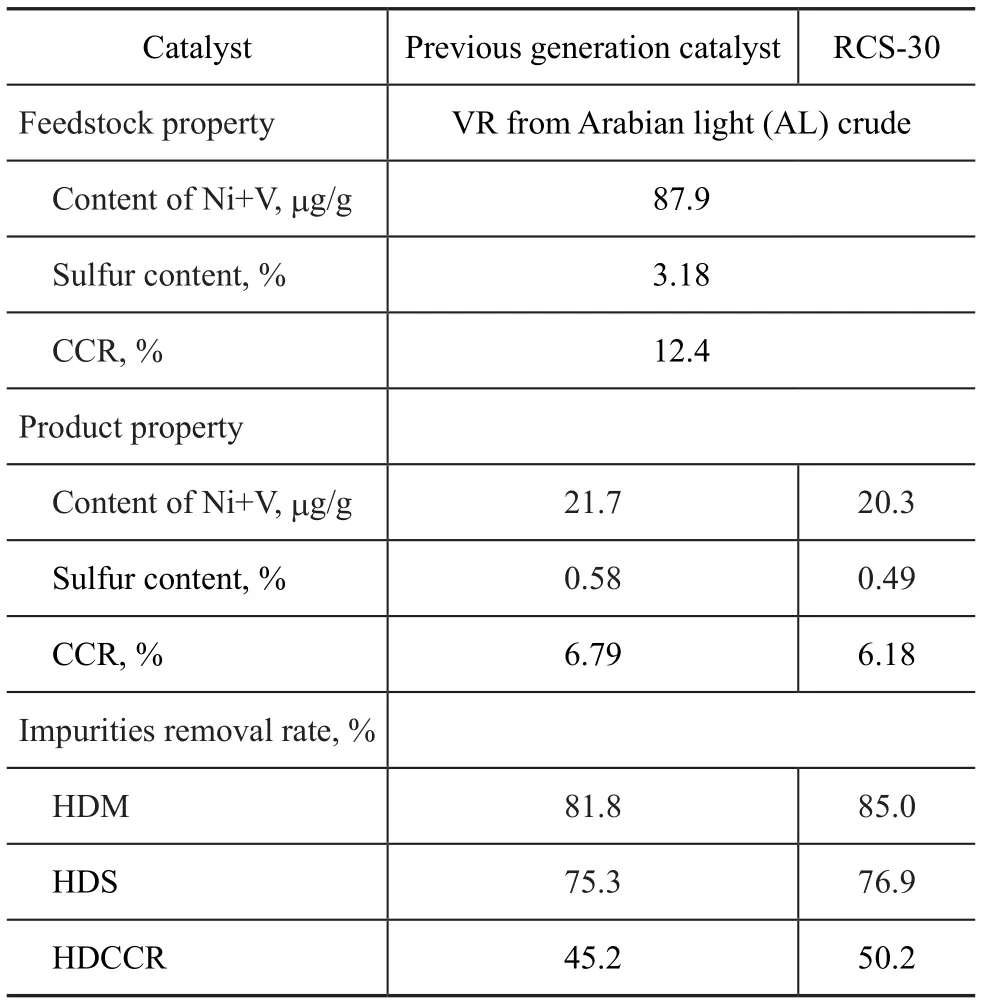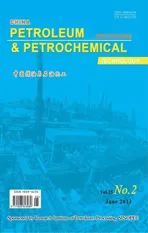Development and Commercial Application of Third Generation Resid Hydrotreating Catalysts
2013-07-25HuDaweiYangQingheDaiLishunZhaoXinqiang
Hu Dawei; Yang Qinghe; Dai Lishun; Zhao Xinqiang
(Research Institute of Petroleum Processing, SINOPEC, Beijing 100083)
Development and Commercial Application of Third Generation Resid Hydrotreating Catalysts
Hu Dawei; Yang Qinghe; Dai Lishun; Zhao Xinqiang
(Research Institute of Petroleum Processing, SINOPEC, Beijing 100083)
Based on the mechanism of resid hydrotreating reaction by coordinating the catalyst activity and stability, the diffusion mechanism and catalyst reactivity, the cost and catalyst performance, and the production and application requirements, the third-generation series catalysts for residue hydrotreating have been developed by Research Institute of Petroleum Processing, SINOPEC. The new series RHT catalysts possess higher activity for HDS, HDM and HDCCR performance as well as longer run length. The commercial results for application of these catalysts have demonstrated that the new catalyst system performs better than the reference ones.
resid hydrotreating; catalysts; HDS; HDM
1 Introduction
Among residue processing methods, the fixed bed hydrotreating technology combined with the fluid catalytic cracking process is becoming one of the most attractive processes for deep conversion of residue. Residue hydrotreating can greatly improve the FCC feed quality. Most of the sulfur, nitrogen, metals and Concarbon (resins, asphaltenes and so on) are removed, and the hydrogen content of the feed is increased, resulting in more valuable light fractions obtained from FCC than other residue processing technologies[1-2]. The key of fixed bed residue hydrotreating technology is to develop a good performance catalyst system. Based on the knowledge on reaction mechanism of residue hydrotreating and the experiences in ten years commercial application of the RHT series catalysts, the third generation RHT catalysts were developed by Research Institute of Petroleum Processing, SINOPEC (RIPP) in 2011. The new series catalysts have been commercialized in the 3.1 Mt/a RDS unit of the Hainan refinery and in the 1.5 Mt/a UFR-VRDS unit of the SINOPEC Qilu Company refinery soon afterwards.
2 Development of Third Generation RHT Catalysts
2.1 Consideration in catalyst developments
Based on the commercial experience of previous two generations of catalysts development and the requirements of FCC for feed quality, the third generation catalysts have improved their reaction stability and reactivity on refractory species such as asphaltenes, resins and polycyclic aromatics. According to the mechanism of residue hydrotreating, the structure and performance of catalyst were tailored to consider the following aspects.
2.1.1 Catalyst activity and stability
Deactivation of residue hydrotreating catalysts is related with two factors[3]. One is the coking of adsorbed polyaromatic species including asphaltenes and resins during the hydrotreating reaction. Another is the continuous metal deposition onto the catalysts in the process of removing impurities from the feed. The analysis of spent catalyst indicated that the deposition of metals on catalyst decreased gradually in a successive order from HDM catalyst in the upper section of reactor to HDS catalyst in the lower section of reactor. The amount of deposited metals on the HDM catalyst is about 4—6 times that on the HDS catalyst. On the contrary, the coked carbon species on the HDS catalyst were significantly more than those on the HDM catalyst. It is obvious that the factors causing cata-lyst deactivation vary with catalysts. Enhancing the metal capacity of HDM catalyst and inhibiting the coking on HDS catalyst would be helpful to maintaining catalyst activity and improving the stability. A new method was used in the preparation of third-generation catalysts in order to make the active metal loading on HDM catalyst like the egg yolk, thus significantly increasing the metal tolerance of HDM catalyst. Through modifying the catalyst surface properties, the amount of coke deposition on HDS catalyst could be reduced greatly, which would further improve the catalyst stability.
2.1.2 Diffusion and performance
The resid hydrotreating reaction rates are controlled by the diffusion of reactants. There are many kinds of reactions like HDM, HDS, HDCCR, etc. The pore structure of the catalyst is a crucial factor influencing the catalyst performance[4]. A new designed carrier with bimodal pore distribution is used in the preparation of the thirdgeneration HDM catalysts. Such catalysts not only have good diffusion performance, but also possess highly active surface area. As regards the HDS and HDCCR catalysts, the surface area of their carrier is maximized while the amount of micropores is minimized. The new carriers can ensure the accessibility of bulk reactant molecules, and keep a proper amount of active sites on the catalyst, which is conductive to improvements in the ability to process complex crude.
2.1.3 Performance and cost
Compared with the distillate hydrogenation catalyst, the residue hydrotreating catalyst cannot be regenerated, and the catalyst operating cycle is shorter. The cost of the catalyst is considered to be more than 10% of the unit operating cost. To be more suited to commercialization needs, effective reduction of the catalyst manufacturing cost becomes an important factor for catalyst manufacturer. It is shown that with metal prices soaring, nearly 60 percent of the catalyst production cost comes from the active metals cost, so a direct and efficient method to reduce catalyst cost is to improve the utilization of active metals. In the course of manufacturing the third generation catalysts, the active metals can be fully utilized through improving the catalyst accessibility. By using the effective preparation method, the active phase structure is optimized and the aggregation of active metal particulates is avoided, and meanwhile the interaction between metals and carrier was regulated. Furthermore, scraps formed during catalyst manufacturing can be recycled to reduce the manufacturing cost significantly. Therefore, the third generation catalysts can have a competitive edge over the previous catalysts.
2.1.4 Catalyst production and application
The process of resid hydrotreating not only can increase the yield of high-quality light fractions, but also can reduce the emission of sulfur and nitrogen compounds. However, the traditional catalyst production technology causes environmental pollution. The manufacture of the third generation catalyst adopts an environmentally friendly technology to eliminate pollutants such as nitric oxide. It is beneficial to reduce catalyst cost through pollution control, which is consistent with the sustainable development idea.
Based on the above-mentioned general ideas, the third generation RHT series catalysts have been developed by RIPP. The properties of RHT series catalysts are listed in Table 1.
2.2 Performance of the third generation RHT catalysts
2.2.1 Performance of catalysts in pilot plant test
The performance of the third generation RHT catalysts for different resid feeds was tested in pilot plant equipped with high-pressure fixed bed reactors. The results are shown in Table 2—Table 5. The demetallation rate of HDM catalyst was by 4%—6.8% higher, the desulfurization rate of HDS catalyst was by 3.7% higher, and the CCR removal rate of HDCCR catalyst was by 5% higher than the reference catalysts respectively. Furthermore, the ability to remove other impurities was also enhanced by the combination of new catalysts. It is helpful to improve the property of final product which is used as FCC feed.

Table 1 Main properties of the third generation RHT series catalysts

Table 2 Results of RDM-32 catalyst activity tests

Table 3 Results of RDM-33B catalyst activity tests

Table 4 Results of RMS-30 catalyst activity tests

Table 5 Results of RCS-30 catalyst activity tests

Table 6 Properties of the Maoming AR
2.2.2 Pilot plant tests of catalyst stability
A superior resid hydrotreating catalyst system requires not only higher activity for impurities removal, but also longer life time. So the stability test of combined new RHT catalysts was carried out using Maoming VR as the feedstock. The feedstock properties are shown in Table 6, with the test results presented in Figure 1. After a continuous run of 3 000 h, the sulfur content in product was less than 0.45%, which was about 0.4% in most of the operating time; the Conradson carbon content in product was less than 6%, which was about 5% in most of the run time. After an operating duration of 1 500 h, the impurity content in the target product was close to the upper limit, and the catalyst bed temperature was then increased by 5 ℃, so that the catalyst after another operating duration of 1 500 h could maintain the product properties very well. The reaction temperatures at which a 91% HDS was obtained during the period covering 1500 h to 3 000 h were normalized. The catalyst deactivation rate was found to be only 0.04 ℃/d during that period. It indicated that the RHT catalysts not only had high activity but also possessed good stability.
2.3 Commercial Application of the third generation RHT catalysts
The third generation RHT catalysts were successively put into application with the expected results in the 1.5 Mt/a UFR-VRDS unit of Qilu Company and in the 3.1 Mt/a ARDS unit of Hainan Company.
The results of the application at Qilu Company are shown in Figure 2—Figure 4. It can be seen from the data in these figures that the operating temperature of referencecatalyst is by 2 ℃—3 ℃ higher than that of RHT catalyst, because the sulfur content in the product obtained by the reference catalyst system exceeded the upper limit. The Conradson carbon content and sulfur content in product obtained by the RHT catalyst is still significantly lower than that of the reference one at lower temperature, indicating that the new RHT catalyst possesses excellent activity and stability. The new RHT catalysts have been running more than three months at the Hainan refinery. Compared with the previous generation catalysts, at a same quality level of products obtained, the operating temperature of the third generation catalyst is obviously lower, which is helpful to extension of the catalyst life to bring about more economic benefits.

Figure 2 Curves of catalysts operation temperature

Figure 3 Sulfur content in product versus run time

Figure 4 CCR in product versus run time
3 Conclusions
(1) By coordinating the catalytic activity and stability, the diffusion mechanism and catalyst reactivity indicators, the cost factor and catalyst performance, and the production capability and application needs, the third generation series catalysts for residue hydrotreating have been successfully developed by RIPP. Upon comparing with the previous generation catalysts, the new series RHT catalysts possess higher activity for HDS, HDM and HDCCR as well as longer run length.
(2) The third generation RHT catalysts were successively put into application. The commercialization results demonstrated that the new series RHT catalysts system perform better than the reference one.
[1] Li Zhiqiang. Heavy oil conversion: focus of petroleum processing technology in the 21st century[J]. Refinery Design, 1999, 29(12): 8-14 (in Chinese)
[2] Liu Jiaming. Application of resid hydrogenation process in China[J]. Petroleum Processing and Petrochemicals, 1998, 29(6): 17-21 (in Chinese)
[3] Guichard B, Roy A, Devers R, et al. Aging of Co(Ni)MoP/ Al2O3catalysts in working state[J]. Catal Today, 2008, 130(1): 97-108
[4] Hu Dawei, Yang Qinghe, Liu Bin, et al. Development and commercialization of catalyst for up-flow type resid hydrotreating[J]. Petroleum Processing and Petrochemicals, 2006, 37(1): 1-4 (in Chinese)
Recieved date: 2013-03-26; Accepted date: 2013-04-07.
Dr. Hu Dawei, Telephone: +86-10-82369194; E-mail: daweihu.ripp@sinopec.com.
杂志排行
中国炼油与石油化工的其它文章
- Preparation and Catalytic Performance of Potassium Titanate Used as Soot Oxidation Catalyst
- A Probe into Process for Maximization of Low-carbon Olefins via Co-processing of Methanol and Heavy Oil
- Influence of Carbon Content on S Zorb Sorbent Activity
- Propylene Polymerization Catalysts with Sulfonyl Amines as Internal Electron Donors
- Isolation and Characterization of a Thermophilic Oil-Degrading Bacterial Consortium
- Research on Catalytic Properties of Palladium Catalyst Prepared by Biological Reduction Method
